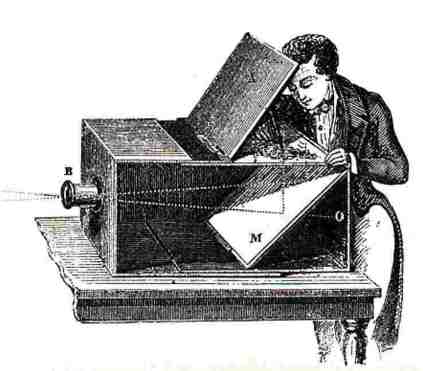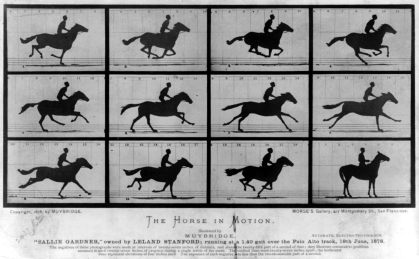 REA 01. PRECURSORS OF FILM.
REA 01. PRECURSORS OF FILM.
.
One of the first technological precursors of film is the pinhole camera, followed by the more advanced camera obscura, which was first described in detail by Alhazen in his Book of Optics (1021), and later perfected by Giambattista della Porta. Light is inverted through a small hole or lens from outside, and projected onto a surface or screen. Using camera obscura, it is possible to create a projected moving image, but, in the absence of recording technology, only in real-time.
In 1739 and 1748, David Hume published A Treatise of Human Nature and An Enquiry concerning Human Understanding, arguing for the associations and causes of ideas with visual images, in some sense forerunners to the language of film. Moving images were produced on revolving drums and disks in the 1830s with independent invention by Simon von Stampfer (Stroboscope) in Austria, Joseph Plateau (Phenakistoscope) in Belgium and William Horner (Zoetrope) in Britain.
On June 19, 1872, under the sponsorship of Leland Stanford, Eadweard Muybridge successfully photographed a horse named “Sallie Gardner” in fast motion using a series of 24 stereoscopic cameras. The experiment took place on June 11 at the Palo Alto farm in California with the press present. The exercise was meant to determine whether a running horse ever had all four legs lifted off the ground at once. The cameras were arranged along a track parallel to the horse’s, and each camera shutter was controlled by a trip wire which was triggered by the horse’s hooves. They were 21 inches apart to cover the 20 feet taken by the horse stride, taking pictures at one thousandth of a second.
Étienne-Jules Marey invented a chronophotographic gun in 1882, which was capable of taking 12 consecutive frames a second, recording all the frames on the same picture. He used the chronophotographic gun for studying animals and human locomotion. The second experimental film, Roundhay Garden Scene, filmed by Louis Le Prince on October 14, 1888 in Roundhay, Leeds, West Yorkshire, England, UK is now known as the earliest surviving motion picture.
On June 21, 1889, William Friese-Greene was issued patent no. 10131 for his ‘chronophotographic‘ camera. It was apparently capable of taking up to ten photographs per second using perforated celluloid film. A report on the camera was published in the British Photographic News on February 28, 1890. On 18 March, Friese-Greene sent a clipping of the story to Thomas Edison, whose laboratory had been developing a motion picture system known as the Kinetoscope. The report was reprinted in Scientific American on April 19. Friese-Greene gave a public demonstration in 1890 but the low frame rate combined with the device’s apparent unreliability failed to make an impression.
As a result of the work of Etienne-Jules Marey and Eadweard Muybridge, many researchers in the late 19th century realized that films as they are known today were a practical possibility, but the first to design a fully successful apparatus was W. K. L. Dickson, working under the direction of Thomas Alva Edison. His fully developed camera, called the Kinetograph, was patented in 1891 and took a series of instantaneous photographs on standard Eastman Kodak photographic emulsion coated on to a transparent celluloid strip 35 mm wide. The results of this work were first shown in public in 1893, using the viewing apparatus also designed by Dickson, and called the Kinetoscope.
This was contained within a large box, and only permitted the images to be viewed by one person at a time looking into it through a peephole, after starting the machine by inserting a coin. It was not a commercial success in this form, and left the way free for Charles Francis Jenkins and his projector, the Phantoscope, with the first showing before an audience in June 1894. Louis and Auguste Lumière perfected the Cinématographe, an apparatus that took, printed, and projected film. They gave their first show of projected pictures to an audience in Paris in December 1895.
After this date, the Edison company developed its own form of projector, as did various other inventors. Some of these used different film widths and projection speeds, but after a few years the 35-mm wide Edison film, and the 16-frames-per-second projection speed of the Lumière Cinématographe became standard. The other important American competitor was the American Mutoscope & Biograph Company, which used a new camera designed by Dickson after he left the Edison company.
At the Chicago 1893 World’s Columbian Exposition, Muybridge gave a series of lectures on the Science of Animal Locomotion in the Zoopraxographical Hall, built specially for that purpose in the “Midway Plaisance” arm of the exposition. He used his zoopraxiscope to show his moving pictures to a paying public, making the Hall the first commercial film theater.
William Kennedy Laurie Dickson, chief engineer with the Edison Laboratories, is credited with the invention of a practicable form of a celluloid strip containing a sequence of images, the basis of a method of photographing and projecting moving images. Celluloid blocks were thinly sliced, then removed with heated pressure plates. After this, they were coated with a photosensitive gelatin emulsion.
In 1893 at the Chicago World’s Fair, Thomas Edison introduced to the public two pioneering inventions based on this innovation; the Kinetograph – the first practical moving picture camera – and the Kinetoscope. The latter was a cabinet in which a continuous loop of Dickson’s celluloid film (powered by an electric motor) was back lit by an incandescent lamp and seen through a magnifying lens. The spectator viewed the image through an eye piece. Kinetoscope parlours were supplied with fifty-foot film snippets photographed by Dickson, in Edison’s “Black Maria” studio. These sequences recorded both mundane incidents, such as Fred Ott’s Sneeze, and entertainment acts, such as acrobats, music hall performers and boxing demonstrations.
Kinetoscope parlors soon spread successfully to Europe. Edison, however, never attempted to patent these instruments on the other side of the Atlantic, since they relied so greatly on previous experiments and innovations from Britain and Europe. This enabled the development of imitations, such as the camera devised by British electrician and scientific instrument maker Robert W. Paul and his partner Birt Acres.
In 1887 Ottomar Anschütz, wanting to display moving pictures to large groups of people, presented his Electrotachyscope that used 24 images on a rotating glass disk. In 1894 his invention projected moving images in Berlin. At about the same time, in Lyon, France, Auguste and Louis Lumière invented the cinematograph, a portable camera, printer, and projector. In late 1895 in Paris, father Antoine Lumière began exhibitions of projected films before the paying public, beginning the general conversion of the medium to projection (Cook, 1990). They quickly became Europe’s main producers with their actualités like Workers Leaving the Lumière Factory and comic vignettes like The Sprinkler Sprinkled (both 1895). Even Edison, initially dismissive of projection, joined the trend with the Vitascope, a modified Jenkins’ Phantoscope, within less than six months. The first public motion-picture film presentation in the world, though, belongs to Max and Emil Skladanowsky of Berlin, who projected with their apparatus “Bioscop“, a flicker-free duplex construction, November 1 through 31, 1895. That same year in May, in the USA, Eugene Augustin Lauste devised his Eidoloscope for the Latham family. But the first public screening of film ever is due to Jean Aimé “Acme” Le Roy, a French photographer. On February 5, 1894, his 40th birthday, he presented his “Marvellous Cinematograph” to a group of around twenty show business men in New York City.
The films of the time were seen mostly via temporary storefront spaces and traveling exhibitors or as acts in vaudeville programs. A film could be under a minute long and would usually present a single scene, authentic or staged, of everyday life, a public event, a sporting event or slapstick. There was little to no cinematic technique: no editing and usually no camera movement, and flat, stagy compositions. But the novelty of realistically moving photographs was enough for a motion picture industry to mushroom before the end of the century, in countries around the world. “The Cinema was to offer a cheaper, simpler way of providing entertainment to the masses. Filmmakers could record actors’ performances, which then could be shown to audiences around the world. Travelogues would bring the sights of far-flung places, with movement , directly to spectators’ hometowns. Movies would become the most popular visual art form of the late late Victorian age“.
.
.
|
.




This iss a very good tip especially to those fresh to the blogosphere.
Brief but very precise info… Thank you foor sharing this one.
A must read post!